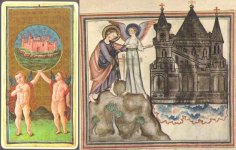... the far overlooked role of women in the genesis of Tarot ..
... Perhaps you know this joke about modern art:
"Some visitors discuss intensively the composition of some objects in the gallery, and develop various interpretations ... then suddenly the cleaning woman appears and takes her cleaning tools with her, leaving the puzzled visitors with the problem, where the considered art objects have disappeared to ..."
So all these deep interpretations about Tarot iconography do not really consider, who were the users of this cards ... and there is a humble observation. These cards were for high educated women, not for high educated men. High educated men played chess.
"Jerusalem" was likely attractive for male crusaders .... women are not male and women are not crusaders.
The Visconti-Sforza card shows two putti, which look like kids. Women love kids.
They point to or carry a city. The Livre de la cite des dames (1404-05)
was written by Christine de Pizan, fighting against various male dominances of her time.
http://home.infionline.net/~ddisse/christin.html#anchor95654
The Iustitia of the 14 Bembo cards is not a common cardinal virtue Iustitia - there is a courting knight in the background. This seems to present a special female idea of justice, not identical to the usual male idea of it.
The triumphal chariot of the 14 Bembo cards - as that of the Cary-Yale and that of other Visconti-cards - is not led by a male, but by a female.
The negative cards - Fool and Traitor - are men, not women. Leaving them aside together with death (neutral, no gender) and judgment, then we've
MALE:
Magician
Emperor
Pope
Time
MIXED:
Love
FEMALE
Popess
Empress
Chariot
Justice
Fortuna - with male figures dancing around her
... then we've a female dominance in the deck (with thanks to the female charioteer).
It was a deck for women, not for men. Commissioned with a female eye, not a male. By Bianca Maria Visconti, not Francesco Sforza.
1.1.1441 - a situation dominated by young women, in modern eyes "girls" or "teenagers". Highstanding teenagers ... but teenagers. Female teenagers -not old crusaders. With marriage-dreams. With Garden-of-love-stories in their head. Waiting for the prince to come.
http://trionfi.com/0/d/



